


Influence of copper ions on reactivity of aluminium
Metallic aluminium is known for its high resistance against corrosion. It is corroded by acids, but only slowly, when the acid is not too concentrated. By water and neutral salt solutions, the metal normally is not attacked at all at any visible rate.
When copper ions are present, together with chloride ions, then things change considerably. Even neutral solutions of copper salts are capable of quickly eating away aluminium metal, when some chloride is present. The remarkable thing is that without chloride or without copper no such reaction occurs. Both ions need to be present in order to get a violent reaction.
![]() Be careful, when performing this experiment. The reaction can become extremely
violent. When the experiment is performed, as indicated here, then it can be
carried out safely. The experiment should not be scaled up to large amounts.
Be careful, when performing this experiment. The reaction can become extremely
violent. When the experiment is performed, as indicated here, then it can be
carried out safely. The experiment should not be scaled up to large amounts.
![]()
![]() Required
chemicals:
Required
chemicals:
-
aluminium foil, household foil is suitable
- sodium chloride, table salt is suitable
- copper sulfate
- dilute hydrochloric acid, 5 - 10% by weight
![]() Required
equipment:
Required
equipment:
-
test tubes
![]() Safety:
Safety:
- Dilute hydrochloric acid is corrosive
- Copper salts are moderately toxic
-
 The reaction can
become very violent, and a lot of heat is produced. Only small amounts
should be used.
The reaction can
become very violent, and a lot of heat is produced. Only small amounts
should be used.
![]() Disposal:
Disposal:
- The copper waste should not be flushed down the drain. Solid copper waste can be wrapped in a piece of paper and should be kept aside for proper disposal.
![]()
Preparing solutions, in which aluminium foil does not dissolve
![]() In two different test tubes put small pieces of household
aluminium foil. In one of the test tubes put some table salt and in the other
put some solid copper sulfate. Next, add some water to both of the test tubes.
If the table salt does not dissolve completely clear, then add a few drops of
dilute hydrochloric acid. The result is shown in the two pictures below. The
solutions contain the solid piece of aluminium, which does not show any
reaction, not even after several minutes.
In two different test tubes put small pieces of household
aluminium foil. In one of the test tubes put some table salt and in the other
put some solid copper sulfate. Next, add some water to both of the test tubes.
If the table salt does not dissolve completely clear, then add a few drops of
dilute hydrochloric acid. The result is shown in the two pictures below. The
solutions contain the solid piece of aluminium, which does not show any
reaction, not even after several minutes.
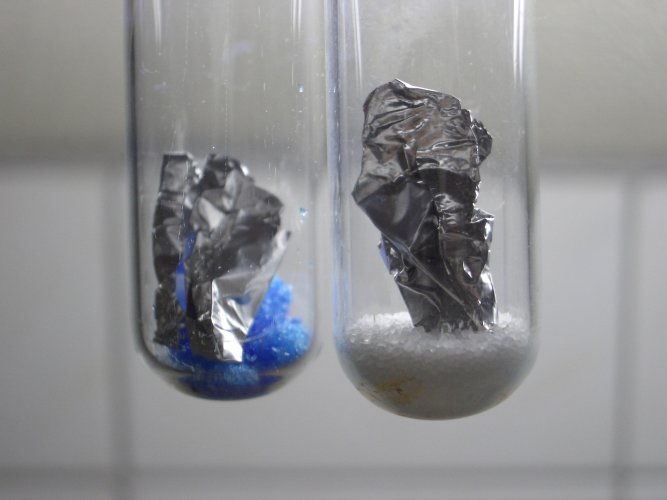
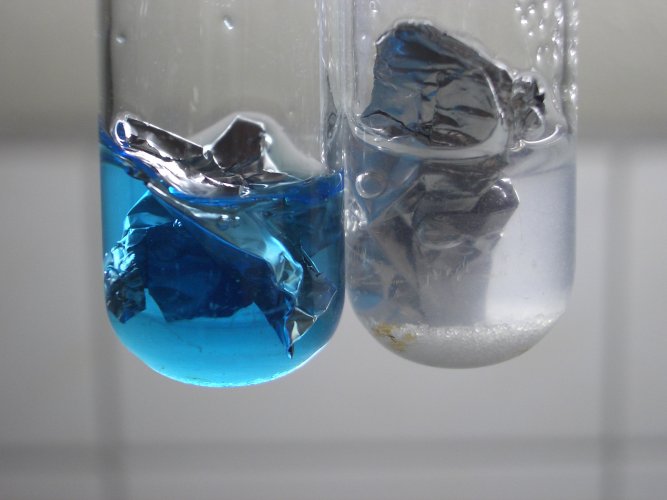
Mixing solutions and causing quick dissolving of the foil
![]() Add the
blue liquid from the left test tube to the right test tube. Leave the piece of
aluminium foil in the left test tube. This is used later on. As soon as the blue
solution of copper sulfate is added to the right test tube, a fairly vigorous
reaction can be observed. The liquid becomes green, due to formation of the
tetrachlorocuprate (II) complex and the aluminium reacts vigorously, with
formation of hydrogen and formation of finely divided copper metal. The
left picture shows the contents of the test tube, immediately
after adding the solution of copper sulfate, the right picture shows the same
test tube approximately 15 seconds later.
Add the
blue liquid from the left test tube to the right test tube. Leave the piece of
aluminium foil in the left test tube. This is used later on. As soon as the blue
solution of copper sulfate is added to the right test tube, a fairly vigorous
reaction can be observed. The liquid becomes green, due to formation of the
tetrachlorocuprate (II) complex and the aluminium reacts vigorously, with
formation of hydrogen and formation of finely divided copper metal. The
left picture shows the contents of the test tube, immediately
after adding the solution of copper sulfate, the right picture shows the same
test tube approximately 15 seconds later.
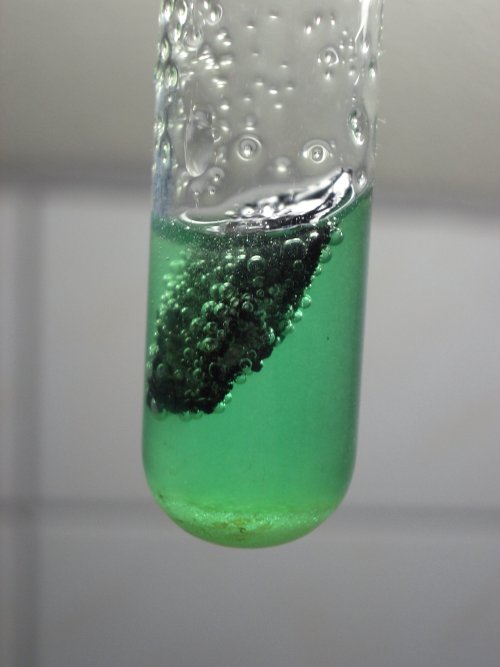
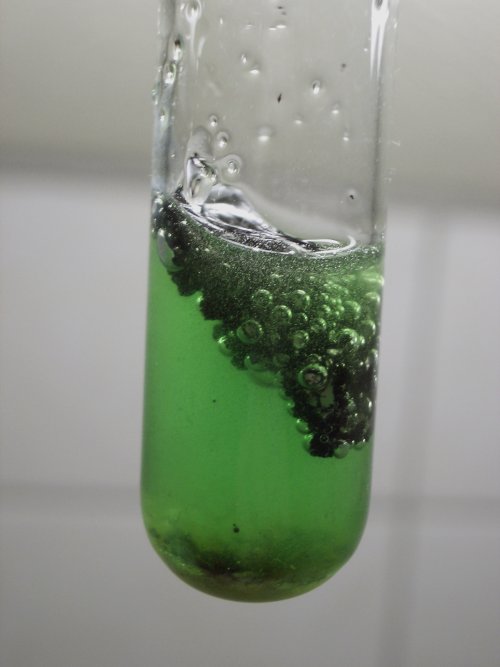
![]()
Addition of more table salt and more aluminium
![]() Now,
additional table salt and a small amount of dilute hydrochloric acid is added to
the other test tube with the undissolved piece of aluminium foil. This mix is
quickly added to the test tube with the green copper solution and the partly
dissolved piece of aluminium foil. Now the second piece of aluminium foil also
quickly dissolves and the liquid becomes quite hot. The reaction becomes more
and more vigorous. The three pictures show the reaction of the aluminium and the
formation of more and more of a solid precipitate, which later on appears to be
fairly pure copper metal.
Now,
additional table salt and a small amount of dilute hydrochloric acid is added to
the other test tube with the undissolved piece of aluminium foil. This mix is
quickly added to the test tube with the green copper solution and the partly
dissolved piece of aluminium foil. Now the second piece of aluminium foil also
quickly dissolves and the liquid becomes quite hot. The reaction becomes more
and more vigorous. The three pictures show the reaction of the aluminium and the
formation of more and more of a solid precipitate, which later on appears to be
fairly pure copper metal.
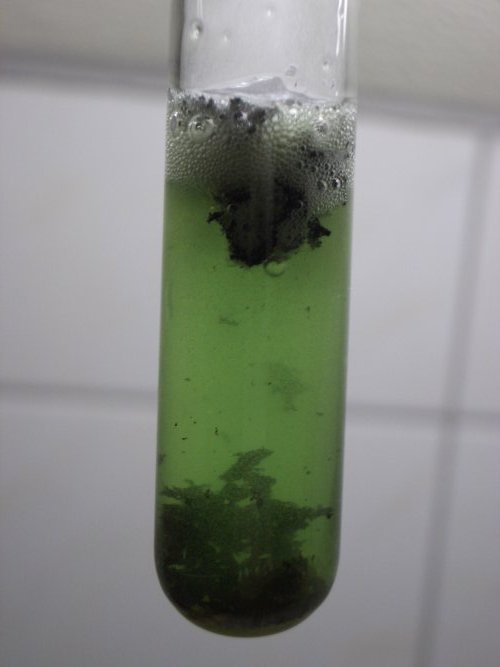
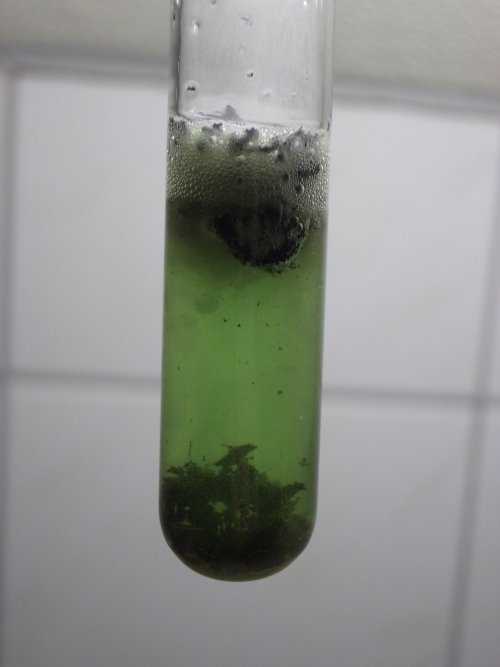
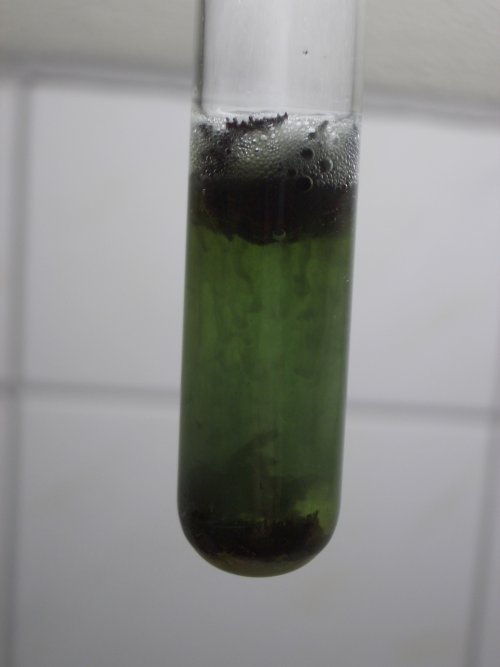
Above the liquid a white spray of tiny droplets, looking like a white fume, can be observed. This is due to the rise of temperature, combined with the vigorous fizzling of the piece of the aluminium in the slightly acidified copper sulfate/sodium chloride solution.
When the reaction comes to an end, then the dark green liquid can be decanted from the precipitate at the bottom and the precipitate can be rinsed by adding water, letting the precipitate settle and decanting the water. When this procedure is repeated a few times, then a final red/brown precipitate is obtained of reasonably pure copper. The following picture shows the red copper precipitate, sticking to the glass of a test tube, from which almost all liquid is decanted.
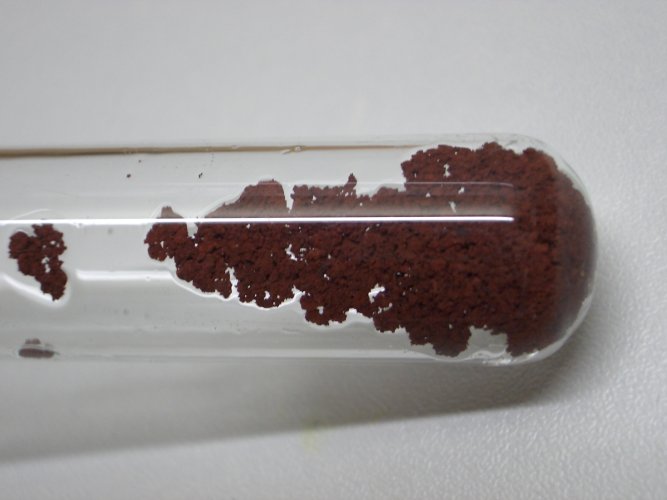
![]()
Discussion of the results
Aluminium is a very reactive metal, which is very electropositive. The reason that it normally does not react quickly is due to formation of a protective oxide layer, which covers the underlying reactive metal. The metal does not react with water, nor air under normal conditions.
Acids are capable of slowly dissolving the protective oxide layer, exposing the reactive metal to the environment. The metal slowly dissolves in dilute acids, it quickly dissolves in concentrated hydrochloric acid, but only after a certain induction period, in which the oxide layer dissolves.
The oxide layer also protects the aluminium from the copper sulfate solution and the sodium chloride solution. The few drops of hydrochloric acid, present in the sodium chloride solution do not appreciably dissolve the protective oxide layer.
A remarkable reaction occurs, when the salt solution and the copper sulfate solution are mixed. The protective oxide layer at once is destroyed, probably by complex formation with the copper-chloride combination. The underlying aluminium metal is quickly attacked by the copper ions and the water. The acid is not necessary for the vigorous reaction although it might help a little.
The following reactions occur:
2Al(s) + 6H2O(aq) → 2Al(OH)3(s) + 3H2(g)
2Al(s) + 3CuCl42-(aq) → 2AlCl4–(aq) + 4Cl–(aq) + 3Cu(s)
The aluminium hydroxide does not form a protective layer now. It makes the liquid turbid. The copper does not get finely suspended into the liquid, but is forms fairly coarse flakes, which quickly settle at the bottom.
Probably the aluminium/copper reaction is also fast, due to formation of a copper-aluminium electrolytic couple, which causes the aluminium to be oxidized quickly, while hydrogen from the water is produced at the copper side of the connected metal-pair.
Remaining open question
The exact role of the chloride is not clear precisely to the author of this site. This reaction is remarkable, because both the copper ions and the chloride ions are required for the vigorous reaction. It might be that formation of the AlCl4– complex ion explains the quick reaction, because this ion dissolves and does not contribute to a protective layer.
What however cannot be explained is the quick destruction of the protective oxide layer of the aluminium:
- When aluminium is dissolved in strong hydrochloric acid, then the reaction also becomes vigorous, but it takes quite some time before the reaction really is vigorous. This is due to the fact that the protective oxide layer first must be eaten away by the acid and hence, the reaction at first is very slow and gradually it becomes faster.
- When aluminium is added to a solution, containing chloride ions at high concentration and copper (II), then the violent reaction starts at once.
Remark: An even more spectacular experiment can be performed, by putting a somewhat larger piece of aluminium foil in a beaker and just covering this foil with a thin layer of a saturated salt solution. If the solution is not completely clear, then a small amount of hydrochloric acid may be added, but not too much. Assure that the salt solution really is concentrated. When some solid copper sulfate is added to the foil, then a violent reaction occurs, almost at once. This experiment, however, MUST be done outside, due to the large amount of heat produced and the fume/fine droplets, formed during the experiment.